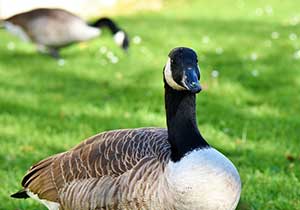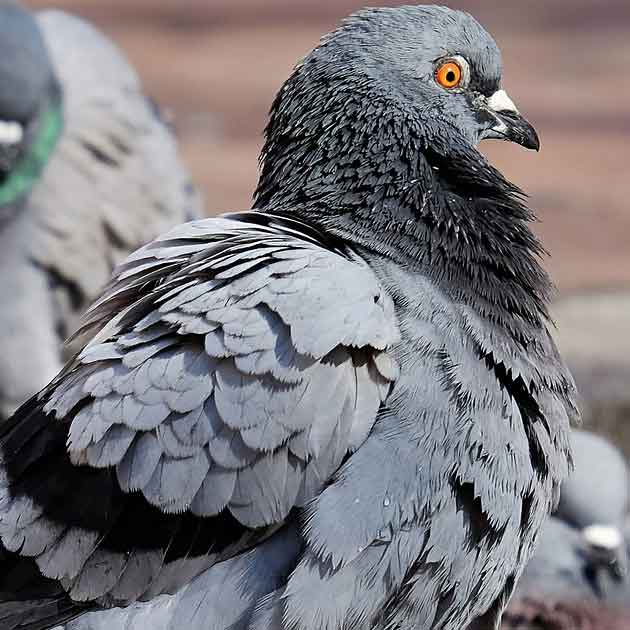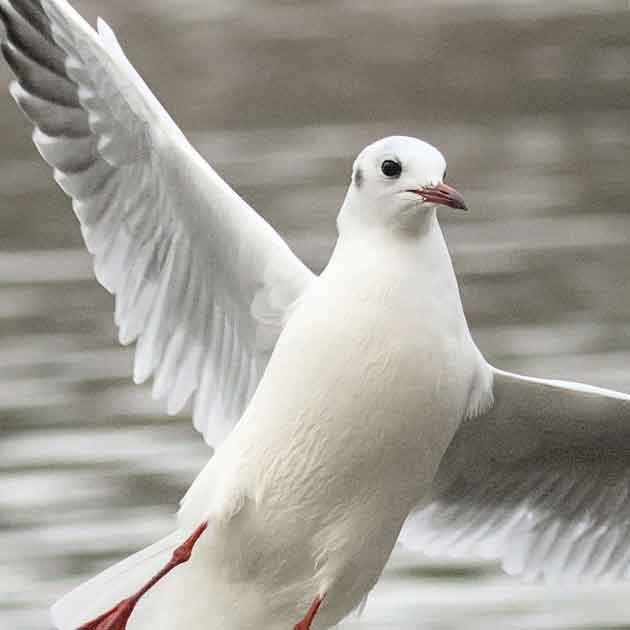 Canada geese are one of the most recognizably large birds in southern Ontario. These waterfowl gather in large groups throughout the spring and early summer, and many populations stay in southern Ontario year-round. They are herbivores and eat mostly young plant shoots and grains, meaning they often congregate on grass lawns, agricultural fields, and construction sites. Because the Canada goose can live up to 20 years, they often return to the same properties each year to nest and moult. Resident populations have grown as much as 250 times over the last few decades due to changes humans have made to the environment. These changes include well-maintained grass lawns and grain fields that provide nutritious food year-round, and suburban developments of open fields and ponds with accessible shorelines that provide an ideal, safe habitat. As a result, the number of conflicts between geese and humans has increased.
Canada geese are one of the most recognizably large birds in southern Ontario. These waterfowl gather in large groups throughout the spring and early summer, and many populations stay in southern Ontario year-round. They are herbivores and eat mostly young plant shoots and grains, meaning they often congregate on grass lawns, agricultural fields, and construction sites. Because the Canada goose can live up to 20 years, they often return to the same properties each year to nest and moult. Resident populations have grown as much as 250 times over the last few decades due to changes humans have made to the environment. These changes include well-maintained grass lawns and grain fields that provide nutritious food year-round, and suburban developments of open fields and ponds with accessible shorelines that provide an ideal, safe habitat. As a result, the number of conflicts between geese and humans has increased.
What damage can Geese cause and why do they have to be removed?
Though Canada geese are not considered a pest species by the Government of Canada, they certainly are a nuisance. As their population has increased over the last several decades, conflicts between geese and humans have risen. Geese are often noisy and intrusive in large groups, and they can rip apart a grass lawn or garden by feeding. Another major way geese can destroy your property is through their feces. Their feces can act as a corrosive agent and can easily damage tar-based roofing material and industrial machinery. Also, their droppings can be an unsightly aspect of any lawn or property. Another major area of concern is geese in airports. Large flocks of geese in the airspace and immediate areas around an airport create a risk of hitting and damaging incoming or outgoing aircrafts. This can be dangerous for both geese and humans. Finally, Canada geese can become very aggressive while nesting; they will attack humans and other animals they deem to be threats. Though their antics can be quite humorous, Canada geese can be vicious and can easily seriously harm a small child or animal.
How and when can I get authorization to remove Geese from my property?
Canada geese are protected under the Migratory Birds Convention Act 1994, and therefore many techniques used to deter them from properties require a Canadian Wildlife Service (CWS) Migratory Bird Permit. The best time to obtain a permit is in January and February, because they can often take a while for CWS to process. Hawkeye can obtain the permits on the customer’s behalf to ensure that bird control can proceed in the most efficient way.
Where and when do Geese become a problem?
Canada geese first become a problem for many people at the beginning of nesting season, when they pair up with their mate and choose a territory. This usually occurs in early to mid-March in Southern Ontario. From late March to late April, the geese will lay up to 10 eggs (typically 4 or 5), which will hatch around mid-May, although some geese will nest later and may not hatch their young until as late as early June. These geese are opportunistic nest builders and will make nests from almost anything, but usually build mats of grasses and reeds near wetlands or ponds. Ideal habitats like these can support many pairs of geese. However, they will also make their nests on cliffs, trees, barges, apartment balconies, and rooftop gardens as long as there is a nearby water source. Though geese generally hang out near the nesting sites while laying, incubating, and raising their brood, they often forage during the day away from the site and return at night. These nesting sites can cause unwanted interactions and conflicts in places like urban parks, golf courses, and cemeteries when there are many birds. Even a single pair may become a significant problem in residential areas, such as rooftop gardens, balconies, or flower boxes.
And then, there are airports - and the potential for bird strikes. Because of their size, a collision between a goose or a flock of geese and an aircraft can lead to catastrophic consequences.
What can be done in the early springtime to stop Geese from nesting?
Once geese have picked out a nesting territory and laid eggs, it can be challenging to convince them to leave. It is easiest to discourage them from nesting as soon as they arrive at your property. Scaring or "hazing" geese is an effective method to stop them from settling in an unwanted area. It involves chasing geese away every time they show up until they leave. Hawkeye uses many techniques to scare geese, including using remotely operated vehicles (ROVs), dogs, and birds of prey to chase the birds, as well as using pyrotechnics and lasers to scare them further. Dogs and ROVs will chase geese on the ground and in the water, and birds of prey like hawks, falcons, and especially eagles will chase geese from the air. Hawkeye uses firearms that discharge cracker shells, called screamers and bangers, that creates a loud sound to frighten the geese away. The use of ROVs and pyrotechnics to scare geese require a federal permit. The use of birds of prey requires a kill permit issued by Environment Canada. Hawkeye is able to obtain these. The advantage of these methods is that they effectively keep geese away and create an unsafe environment for the geese, therefore discouraging nesting. However, scaring birds away like this must be repeated often, and Hawkeye can return anywhere from 2 days a week to 7 days a week to ensure the geese leave until they nest elsewhere. If birds have become accustomed to nesting on a particular property, it can take some time before the issue is resolved. Once Hawkeye has started working, it can take a couple of years to see a drastic reduction of geese as they learn to stay away, but often we see results quite quickly.
What can we do after Geese have nested?
Between the time when they nest, and when the young geese learn to fly, it is difficult to get rid of them. The parents, especially the males, become extremely protective and will go after humans viciously. This period lasts from mid-March, when they establish territories, to mid to late July, when the young learn to fly and move on from the nesting site. Between early April to mid-May, most geese are incubating their eggs, and there are multiple methods Hawkeye can employ to get rid of the nests and eggs. These methods are called lethal management because they destroy or stop the eggs from hatching and require a federal permit from Canadian Wildlife Services.
Egg sterilization by chemical oiling is one such method. This involves coating the eggs in vegetable or mineral oil, which prevents the birds from hatching. Because the eggs will not hatch, fewer geese will be born in the season, and therefore fewer geese will be present on the property. Unfortunately, this is not the most effective method of dispersing geese. The geese will continue to incubate the eggs and therefore stay in the nest area, for as long as they think the eggs are viable: up to 6 weeks after being oiled. This means that they will continue to aggressively defend their nest to unknowing passers-by. Oiling the eggs does not significantly deter the birds from coming back to the same location to nest next year. When not oiled properly, the eggs may hatch, and deformed geese may be born. Therefore, this technique should be done by a professional and is illegal to do on your own without a permit. Further, the geese may track the oil into a nearby water source, contaminating the water and the ground with chemicals. Finally, complete oiling of the eggs requires as many as 20 visits per month over the two nesting months.
A more effective and much less complicated method is egg destruction and nest removal. When their eggs are destroyed, the geese have no reason to stay through the nesting period and will move on. Because the geese are no longer protecting nests, they become much less aggressive and can be more easily chased away. Moreover, the geese will learn to stay away from this property in subsequent years, as they have learned that this nesting site represents a threat to their eggs.
Since Canadian geese are a protected species, all of these techniques are highly monitored, and permits restrict the number of eggs and nests eligible for destruction based on geese's current population in certain areas.
What about flocks of Geese later in the season?
Once a year, geese moult out their flight feathers and grow new ones, leaving them flightless for 4 to 6 weeks, usually from mid-May to late July. Non-breeding adults will gather in large moulting flocks and pick an area to remain for the remainder of their moult. They will often gather near open sources of water where flightless birds can gain refuge from land predators. Once a moulting flock has gathered and settled into an area, it is very difficult and illegal to scare them away, as they cannot fly and therefore have limited ability to displace themselves. Dogs and birds of prey could easily kill one of the young or flightless birds as they are at a severe disadvantage. Preventing flocks from settling in an area using scaring methods is the most effective way to stop pre-moulting flocks from settling before losing their feathers.
Once they have settled, however, Hawkeye can relocate the flocks. Because they are flightless, moulting geese can be safely rounded up and transported to a more suitable location. Hawkeye typically moves them 300 to 400 km away, so there is no chance of them returning while still moulting. This method requires a federal permit and trained individuals to properly handle the geese, both of which Hawkeye can provide. It effectively keeps the moulting flock away for the rest of the moulting season and can sometimes deter them from returning in subsequent years.
Are there any other, more permanent Geese Removal options?
When other methods fail, shooting birds is an option. With a kill permit and working within the bag limit (the maximum number of game animals permitted to be taken), geese can be shot and killed by professionals. This method is 100 percent effective: what is killed will never come back. Additionally, shooting some geese will scare away others. However, many people oppose such visible lethal management techniques.
Geese can be a very aggravating and even dangerous problem. They can cause a lot of damage to property and cause visual and auditory disturbances. Once they have settled into an area, they are tough to remove, so prevention of geese settling is the most straightforward form of goose control. Hawkeye will work with customers to assess each situation and make recommendations on the best course of action. Hawkeye can ensure effective goose removal in all cases and continue working with customers until all geese are gone.
We are here to help you deal with Pest Bird Control and avoid potential health hazards, costly damage to property, and loss of product and/or productivity (especially in the food and healthcare sectors) if pest birds are not addressed immediately.
Now several Locations in Canada and one in the U.S, we are ready to serve you better in Acton, Toronto, Oshawa, Bowmanville, two locations in Mississauga and West Palm Beach in Florida.
Contact us today or Email us at [email protected] if you need help with pest bird control and/or pest bird removal.
We also deal with Pest Birds such as Cormorants, Crows, Ducks, Doves, Geese, Grackels, Seagulls, Pigeons, Robins, Sparrows and Starlings.
Related Articles: https://www.hawkeye.ca/blog/geese-nest-removal-in-brampton | https://www.hawkeye.ca/blog/what-to-do-if-a-goose-attacks-you-or-a-pet














